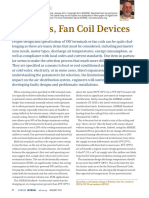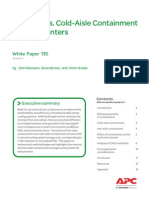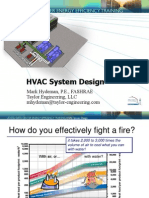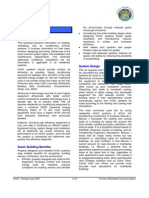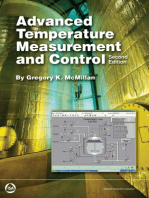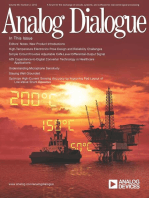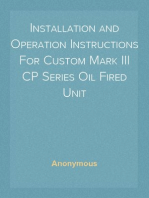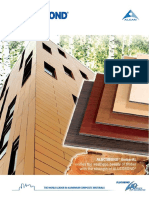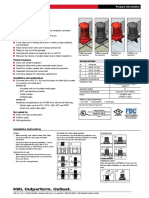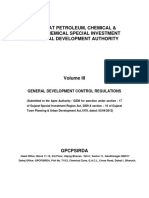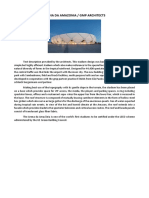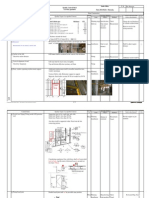Ashrae Journal On Reheat: Dan Int-Hout
Ashrae Journal On Reheat: Dan Int-Hout
Uploaded by
Sergio GarroCopyright:
Available Formats
Ashrae Journal On Reheat: Dan Int-Hout
Ashrae Journal On Reheat: Dan Int-Hout
Uploaded by
Sergio GarroOriginal Description:
Original Title
Copyright
Available Formats
Share this document
Did you find this document useful?
Is this content inappropriate?
Copyright:
Available Formats
Ashrae Journal On Reheat: Dan Int-Hout
Ashrae Journal On Reheat: Dan Int-Hout
Uploaded by
Sergio GarroCopyright:
Available Formats
ASHRAE Journal / Reheat
Page: 1 of 7
ASHRAE JOURNAL ON REHEAT
_______________________________
Dan Int-Hout
Chief Engineer
Krueger Corporate Headquarters
1401 N. Plano Rd. Richardson, TX 75081
Phone: (972) 680-9136 | Fax: (972) 497-0450 | E-Mail: kruegerinfo@krueger-hvac.com
www.krueger-hvac.com
ASHRAE Journal / Reheat
Page: 2 of 7
Overhead Heating: A lost art.
March 2007 ASHRAE Journal Article
Dan Int-Hout
Chief Engineer, Krueger
VAV terminals provide a measured quantity of conditioned air to a space, in response to a control signal
from a thermostat or room sensor. This air may be tempered with a reheat coil, plenum air, or both. The
means and selection of parameters for this reheat leads to much of the complexity and questions in
selecting and specifying VAV terminals. Selection of the reheat design parameters requires both an
understanding of the limitations of the reheat coil (hot water or electric) and the means of air distribution, if
problems in the installation are to be avoided.
OVERVIEW
The parameters for effective overhead heating were extensively researched by several manufacturers in
the late 70s, when these systems were first being designed and installed. The results of all the research
were similar, and a consensus recommendation was included in the 1979 Fundamentals handbook, and
has been there in every edition since. Unfortunately, discussions with design engineers from Missoula to
San Antonio, and from Los Angeles to Boston reveal that the preponderance of systems are designed for
discharge temperatures in excess of 100oF.
Fig 1
Figure 1 illustrates a common miss-application. Air is discharged at around 100oF, and never reaches the
cold air stream falling down the window. Worse,
ventilation air short circuits back through the return
ceiling plenum, and never reaches the occupants.
The thermostat, meanwhile, may take as long as
an hour to respond to load changes.
The ASHRAE Fundamentals Handbook (2005,
Chapter 33) states that discharging air at a
temperature more than 15oF above the room
Krueger Corporate Headquarters
1401 N. Plano Rd. Richardson, TX 75081
Phone: (972) 680-9136 | Fax: (972) 497-0450 | E-Mail: kruegerinfo@krueger-hvac.com
www.krueger-hvac.com
ASHRAE Journal / Reheat
Page: 3 of 7
(90oF in a 75oF room) will likely result in significant unwanted air temperature stratification (which will void
compliance with ASHRAE Standard 55). In addition, ASHRAE Standard 62.1 2004 (Indoor Air Quality) has
been modified to require increased outside air when heating from the ceiling if this rule is not followed
(Standard 62.1 2004):
This is because hot air tends to stay at the ceiling, and may 'short-circuit' directly back to the room exhaust
without mixing in the room. Indeed, using the ASHRAE 129 test procedure for Air Change Effectiveness,
mixing effectiveness values as low as 20% (or lower) has been observed, when the supply to room
differential exceeds 15oF. Calculations will show that in most cases, it only requires 85oF air to handle a
typical winter design perimeter load at 1 cfm/SqFt. air supply rate (the airflow rate we recommend for both
good ventilation mixing and comfort).
Fig 2
When properly operated, a discharge less than 15oF above room results in higher required airflows, longer
throws, and the room gets mixed. The thermostat responds in a few minutes to changes in loads.
The need to rapidly warm a space following a night setback has another set of requirements. Air needs to
be heated as rapidly as possible, with a maximum of mixing, without too much regard for occupant
comfort. This requires both a high delta-t and a high airflow. Note: The hotter the air temperature, the
longer it will take to heat the room, for a given heat delivery rate!
This is due to stratification of hot air at the ceiling. The engineer therefore needs to ensure that both
occupied heating and morning warm-up situations are covered in his design with proper staged or
proportional electric heat or proportional water coil valves.
Some Energy codes (currently in Florida and California), and ASHRAE 90.1, prohibit reheating cooled air
at more than 30% of design cooling flows. It is unlikely that meeting this requirement will result in
satisfactory diffuser mixing, occupant comfort or ventilation mixing. In temperate climates, this may be a
less than satisfactory, but an understood design compromise. In cold climates, this may not be acceptable.
Of course, the 90.1 prohibition only covers reheating previously cooled air. When the system is in
Krueger Corporate Headquarters
1401 N. Plano Rd. Richardson, TX 75081
Phone: (972) 680-9136 | Fax: (972) 497-0450 | E-Mail: kruegerinfo@krueger-hvac.com
www.krueger-hvac.com
ASHRAE Journal / Reheat
Page: 4 of 7
economizer mode, air is not being reheated. In fact, it may be argued that today, with better wall
insulation and glass, few systems should be in compressor cooling mode when perimeters require reheat.
The reheating of cold primary air seems, on the surface, to be a wasteful practice in terms of optimum
utilization of energy resources. There are many situations, however, where it is not only necessary, but
also beneficial to do so, and can save considerable energy. These include:
1.) Providing comfort with a great diversity of loads: When both heating and cooling is required from a
single air handler, due to climate and building design factors, reheat is often an economical solution.
As it is only used in a few locations, and only part of the time, the energy penalty for reheat is minimal.
2.) Supplementing baseboard perimeter heat: Baseboard heating systems can be the most effective
means of offsetting perimeter heating demand loads. At times, however, peak heating demand loads
may exceed the installed baseboard capacity and supplemental overhead heat can be supplied.
3.) Maintaining minimum ventilation rates: The benefit of an installed re-heat coil in non-perimeter
zones becomes apparent when a minimum ventilation rate exceeds the cooling demand. This happens
when the quantity of supply air to a space required to provide proper ventilation exceeds that required
to offset local heat sources, such as when the ratio of occupants to equipment (which requires little
ventilation air) shifts towards occupants, as in conference rooms. In these cases, the required quantity
of ventilation air may sub-cool the zone.
A slight amount of controlled reheat can prevent this sub cooling. The alternative, reducing supply air
temperature at the air handler, may result in other spaces that cannot be cooled at design maximum
airflows, and also tends to increases space relative humidity.
4.) Controlling Humidity: Humidity control can be enhanced using reheat coils, just as for ventilation
requirements. When the local humidity is too high, then drier cooler air can be added, and then slightly
reheated to avoid sub cooling.
HOT WATER HEAT
Most manufacturers of VAV terminals offer a hot water coil selection program. This selection, however,
cannot defy the basic laws of physics, (regardless of what is specified). Unlike custom air handlers, the fin
spacing, circuiting, and tube spacing are usually fixed for VAV box coils. This means that there is only one
solution for a given gpm, # of rows and airflow rate, for a given coil size.
When selecting a coil, one can pick only one independent variable, with different parameters for increasing
the number of rows, gpm, etc. The selection of the best path almost always requires a discussion with the
engineer. It is necessary to know which item on the provided schedule is to be met. While this should
probably be the BTUH, it is often the gpm (which is apparently set in concrete due to prior pump selection),
etc. Both scheduled gpm and BTUH often cannot be met, (unless of course one will allow fractional rows)
As discussed earlier, the coil leaving air should be fixed so as to not exceed ASHRAEs recommended
15oF delta-t maximum (Chapter 32, Fundamentals Handbook) except in unoccupied morning warm-up, for
effective air distribution in the room. This often requires adjusting the heating CFM to achieve the desired
room BTUH at a discharge air temperature that will promote good room air distribution and ventilation
mixing. This action is apparently seldom performed, but should be.
WATER COIL ISSUES
For fan boxes, the mixed air temperature (the combination of primary and induced air temperatures) is
dependent on the coil location:
Series Fan boxes: As the coil is almost always on the discharge, the mixed air quantity (and the coil
entering air temperature) is based on the fan cfm. The coil entering air temperature is calculated based on
the minimum primary at one temperature and the induced airflow (which is the fan cfm less the minimum
Krueger Corporate Headquarters
1401 N. Plano Rd. Richardson, TX 75081
Phone: (972) 680-9136 | Fax: (972) 497-0450 | E-Mail: kruegerinfo@krueger-hvac.com
www.krueger-hvac.com
ASHRAE Journal / Reheat
Page: 5 of 7
primary) at another temperature. With series flow units, the coil leaving air temperature and the box leaving
air are the same.
Parallel fan boxes: With some parallel fan powered units, the coil location may be on the plenum inlet so
the coil entering air is always the plenum air temperature. There is mixing after the coil, however. The units
discharge air temperature is therefore a mix of primary air, typically at the minimum primary air flow rate,
and plenum air heated by the coil, at the fan air flow rate.
Most parallel units have the water coil on the discharge, in spite of the obvious pressure penalty seen by
the primary air handler. When on the plenum inlet, with a high minimum primary air setting (to meet
ventilation minimums) the required coil leaving temperature may exceed 120F, and there is a high
likelihood of cooking the fan motor, forcing the coil to be relocated to the unit discharge.
Leaving Water Temperature: Leaving water temperature should NOT be used in water coil selection.
Cooling coils are often selected on the basis of water coil delta-t, where the discharge temperature is
controlled. This technique, however, is not recommended for heating coils in VAV boxes, where the
discharge temperature is seldom controlled. It is recognized that non condensing boilers require a high
entering water (return water) temperature to avoid shocking the system. This should be accomplished
through three-way valves, secondary loops, or other means, not through coil selections. At part load, when
the water valve is throttled, coil leaving water temperatures will ALWAYS be less than recommended by
these boilers.
Fluid Type: Three hot fluids are commonly used: Water, Ethylene and Propylene Glycol. The use of Glycol
will significantly increase the minimum gpm allowed for turbulent flow. Most programs compute a Reynolds
number, which must be greater than 5000 for a valid selection, and which increases the minimum gpm as
the percentage of glycol increases.
Coil Load vs. Room Load: A water coil is often selected based on a given BTUH. There are, however, two
loads that can be used for this calculation. One is the coil load, which is based on the air flow rate and the
supply to discharge temperature differential. The other is the room load, which is the difference between
the room temperature and the discharge temperature, and may be calculated from skin losses less internal
loads. Often, it is not clear which is being specified. Most software assumes the BTUH load is the coil
load.
ELECTRIC HEAT
The electric heater provided with most single duct VAV boxes is essentially a rated duct heater installed in
an elongated single duct unit. This longer unit provides for developed flow, after the damper, and a
relatively uniform airflow across the coil elements. At low flows, however, there is both a minimum airflow
and a maximum kW consideration. The heater has a safety switch that prevents the heater from engaging
unless there is a minimum sensed pressure in the duct. Normally, this is a velocity pressure, although in
practice, it sometimes becomes a static pressure sensor.
At low airflows, there may be insufficient velocity, or static pressure, in the unit to make the contactor in
the flow switch. This may be due to probe location, damper position, low discharge static pressure or likely,
a combination of all. (Note: for fan powered terminals, the minimum fan setting is sufficient to operate the
electric heat) The kW selected at minimum flow must also avoid exceeding the maximum UL listed coil
temperature of 120F.
OVERHEAD HEAT AND THE DIFFUSER
Besides the minimum flow to activate the heater safety circuits, there is an issue of the diffuser
performance. All diffusers have a specific performance envelope in cooling mode, which can be
determined through ADPI analysis. (See D. Int-Hout, Best Practices for Diffuser selection, ASHRAE
Journal, June, 2004) With VAV systems, diffusers should be selected so that at full flow they are near the
Krueger Corporate Headquarters
1401 N. Plano Rd. Richardson, TX 75081
Phone: (972) 680-9136 | Fax: (972) 497-0450 | E-Mail: kruegerinfo@krueger-hvac.com
www.krueger-hvac.com
ASHRAE Journal / Reheat
Page: 6 of 7
limit of objectionable sound, so as to allow for optimum performance at reduced flows. VAV boxes are also
selected at as high an inlet velocity as possible, for the same reason. When heated air is being discharged
from a ceiling diffuser, the outlet velocity needs to be as high as possible, to prevent stratification. Airflows
even close to the manufacturers electric heating minimum airflow unlikely to be satisfactory from an air
distribution standpoint, and short circuiting of ventilation air and excessive temperature stratification are
likely, regardless of the resultant discharge temperature.
It some cases, it may be desirable to decouple
the heating and cooling air supply to the room.
One option is to use down blow nozzles at the
window supplied from a heating only fan coil. A
parallel fanbox controller on the single duct VAV
terminal used for cooling can control this fan coil.
With fan boxes, the fans minimum flow rate is
sufficient to permit electric heater operation, so
there is no minimum setting or requirement.
Additionally, as there is minimum reheat, energy
codes are satisfied, and diffuser performance is
maintained. As a result, when restrictive energy
codes are in place, fan powered terminals may be
required for acceptable environments and
ventilation mixing, instead of shut off single duct
units.
As mentioned earlier, the ASHRAE Handbook recommends a maximum discharge temperature of 90oF
(in a 75oF room) with overhead heating to avoid excessive stratification (and ventilation short-circuiting).
Many times, simple logic can be applied to select suitable conditions of airflow and reheat which maintain
room air mixing, diffuser performance and air change effectiveness, within the factory airflow and kW
limitations for units with electric heaters. Setting one cfm/sqft as a heating flowrate in perimeter zones is
recommended to achieve optimum air distribution when heating.
HEAT CONTROL
The control of heat to a space is primarily the responsibility of the supplied controls. The controller
provides staged contacts for heat to an electric heater, and either a single contact for on-off, or two
contacts for three point floating outputs to a hot water valve. The control is most often open loop, in that
the controller relies on feedback from the room sensor to modify the heater control signal. If a room is
stratified (as when the discharge air temperature is greater than ASHRAEs recommended 15oF delta-t,)
the time response may be very slow, resulting in considerable room temperature swings (in addition to the
unacceptable room temperature stratification). The indicated temperature at the room sensor will, however,
indicate acceptable temperature.
New technologies permit proportional discharge temperature controlled heat for VAV boxes, at a very low
cost. The controller is connected either to a proportional hot water valve, or a single stage digital relay
electric heater. When tied with a discharge temperature sensor, will allow the controller to set the desired
discharge temperatures as a function of the DDC controllers demand. This technology allows for a better
control of space temperature than most other methods. It can be driven by a variety of application
sequences using proportional (0-10 VDC or 0-20 mA) output, pulsing or staged 24 VAC output. The use of
a three-point floating heater control option with either hot water or electric heat often reduces the cost
of the DDC controller by as much as $100 compared to a proportional output on the DDC controller. Some
DDC manufacturers do not have an analog output option available at all.
Krueger Corporate Headquarters
1401 N. Plano Rd. Richardson, TX 75081
Phone: (972) 680-9136 | Fax: (972) 497-0450 | E-Mail: kruegerinfo@krueger-hvac.com
www.krueger-hvac.com
ASHRAE Journal / Reheat
Page: 7 of 7
When the discharge temperature sensor is installed, one can control proportionally between the no-heat
duct temperature and a set maximum temperature.
SUMMARY
Overhead heating has been the primary method of offsetting perimeter winter loads with VAV systems for
30 years. Research was conducted on the rules to avoid excessive stratification and provide occupant
comfort back then, and included in the ASHRAE Handbooks ever since. In spite of this, however,
engineers continue to design systems delivering low velocity, high temperature air at the ceiling. These
designs are almost guaranteed to result in spaces which do not meet the minimum requirements of
ASHRAE Standard 55, and also fail to consider new ventilation requirements in ASHRAE Standard 62.1.
Electric and hot water reheat coils are provided on many types of VAV terminals. There are selection
criteria for each that should be considered both to ensure proper unit performance and to distribute the
heated air properly into the space. With all, however, the engineer should assure that the discharge
temperatures and air quantities will provide a comfortable space, and provide ventilation mixing as well. It
will often be necessary for the equipment supplier and control contractor to discuss these issues with the
design engineer before making a final selection to ensure that everyone is making the same assumptions
Meeting both ASHRAE Standard 62.1 and Standard 55, without violating 90.1, requires proper selection of
both heating control and heating equipment, as well as air delivery devices. As 62.1 is a prerequisite of the
current LEED requirements, and likely to be incorporated into the next version of the International
Mechanical Code, it is essential that these issues be understood by all parties. And code issues aside, if
the vertical temperature requirements of Standard 55 are not met, occupants will employ their own means
of providing space comfort (the dreaded 1500 watt heaters), or worse, move out.
Krueger Corporate Headquarters
1401 N. Plano Rd. Richardson, TX 75081
Phone: (972) 680-9136 | Fax: (972) 497-0450 | E-Mail: kruegerinfo@krueger-hvac.com
www.krueger-hvac.com
You might also like
- Article Vav CoilsDocument5 pagesArticle Vav Coilsfatima el karmiNo ratings yet
- Article Vav CoilsDocument5 pagesArticle Vav Coilsfatima el karmiNo ratings yet
- Vav Box Reheat Selection: Krueger KruegerDocument5 pagesVav Box Reheat Selection: Krueger KruegerKia KhosraviNo ratings yet
- 80-1-IsD - Condensation Control On Air Conditioning DuctsDocument4 pages80-1-IsD - Condensation Control On Air Conditioning DuctsHumaid ShaikhNo ratings yet
- VentillationDocument13 pagesVentillationhurry yashwantNo ratings yet
- Hot Vs Cold Aisle Containment For DCDocument13 pagesHot Vs Cold Aisle Containment For DCtommylaw100% (1)
- HVAC System Design: Mark Hydeman, P.E., FASHRAE Taylor Engineering, LLCDocument42 pagesHVAC System Design: Mark Hydeman, P.E., FASHRAE Taylor Engineering, LLCsardarmkhanNo ratings yet
- 4 Hvac 101807Document42 pages4 Hvac 101807ubedullahNo ratings yet
- APH Bid Assessment - HowdenDocument14 pagesAPH Bid Assessment - Howdenv_mokadam100% (2)
- Hvac Thesis TopicsDocument5 pagesHvac Thesis Topicsgj3vfex5100% (2)
- Venting The Engineroom - Professional BoatBuilder MagazineDocument3 pagesVenting The Engineroom - Professional BoatBuilder MagazineHarun KEMALİNo ratings yet
- Room Flow ProDocument12 pagesRoom Flow ProMuhammad Farooq SaeedNo ratings yet
- Best Practices Cooling WPDocument10 pagesBest Practices Cooling WPnoxleekNo ratings yet
- Enews 30 03 090601Document4 pagesEnews 30 03 090601sajuhereNo ratings yet
- Temperature & Humidity Control in Surgery Rooms: Health-Care HVACDocument7 pagesTemperature & Humidity Control in Surgery Rooms: Health-Care HVACRabeya SultanaNo ratings yet
- Pulse Firing BasicsDocument3 pagesPulse Firing BasicsdrbaneNo ratings yet
- 04 - How Does Altitude Affect HVAC UnitsDocument2 pages04 - How Does Altitude Affect HVAC UnitsMaiccoll OlmNo ratings yet
- ASHRAE Journal - How To Design & Control Waterside Economizers-TaylorDocument7 pagesASHRAE Journal - How To Design & Control Waterside Economizers-TaylorsajuhereNo ratings yet
- MASTER - Parallel - Rack - Application - Manual - 2007 - V2 (1) .2 - 11212007Document85 pagesMASTER - Parallel - Rack - Application - Manual - 2007 - V2 (1) .2 - 11212007calvilloNo ratings yet
- Reznor HandbookDocument72 pagesReznor Handbookethen223100% (1)
- District Cooling Best Practices: Design Process and Key IssuesDocument19 pagesDistrict Cooling Best Practices: Design Process and Key Issues9810482818No ratings yet
- OGF 2018 07 Static Equipment Understanding Heat ExchangersDocument15 pagesOGF 2018 07 Static Equipment Understanding Heat Exchangersmostafa morshedyNo ratings yet
- Selecting Air Conditioners For EnclosureDocument7 pagesSelecting Air Conditioners For EnclosureErdinc KlimaNo ratings yet
- Temperature & Humidity Control in Surgery Rooms: Health-Care HVACDocument4 pagesTemperature & Humidity Control in Surgery Rooms: Health-Care HVACvah1967vahNo ratings yet
- HVAC Cold Air DistributionDocument21 pagesHVAC Cold Air DistributionPhanhai KakaNo ratings yet
- 3 Simple WaysDocument7 pages3 Simple WaysAruna Prasanna DewasurendraNo ratings yet
- Flare Sweep GasDocument5 pagesFlare Sweep GasChem.EnggNo ratings yet
- HvacDocument4 pagesHvacFaiz MohNo ratings yet
- Compressor Installation GuideDocument48 pagesCompressor Installation GuideAdeel Sajjad100% (1)
- Ashraed2830420060712Document7 pagesAshraed2830420060712Angel Alvarez CarrilloNo ratings yet
- Offshore Hvac DesignDocument6 pagesOffshore Hvac DesignAndrew Alex100% (1)
- Dissertation HvacDocument8 pagesDissertation HvacCheapPaperWritingServiceAnchorage100% (1)
- Dual Duct Dual FanDocument2 pagesDual Duct Dual FansajuhereNo ratings yet
- Ashrae Handbook Hvac ApplicationsDocument9 pagesAshrae Handbook Hvac Applicationsliza mae remoroza75% (4)
- Advanced VAV GuideDocument7 pagesAdvanced VAV GuidedimchienNo ratings yet
- 7 3 PDFDocument10 pages7 3 PDFrkibNo ratings yet
- BMPS Application Guideline Version2 0 ExampleDocument11 pagesBMPS Application Guideline Version2 0 ExampleLuis RuizNo ratings yet
- Trane Chiller Plant Admapn014en - 0105Document4 pagesTrane Chiller Plant Admapn014en - 0105a_salehiNo ratings yet
- AHU Vs FCU Comparison PDFDocument5 pagesAHU Vs FCU Comparison PDFamirin_kingNo ratings yet
- HVAC Instrumentation & ControlsDocument95 pagesHVAC Instrumentation & ControlsaxelNo ratings yet
- Data Center CoolingDocument28 pagesData Center CoolingImtiaz Ahmed100% (5)
- Controlling Wrap-Around Heat Pipes PDFDocument8 pagesControlling Wrap-Around Heat Pipes PDFothmanNo ratings yet
- Guidelines Provide Offshore HVAC Design Criteria - Oil & Gas JournalDocument8 pagesGuidelines Provide Offshore HVAC Design Criteria - Oil & Gas Journalarunima04No ratings yet
- Combining DOAS and VRF, Part 1 of 2Document8 pagesCombining DOAS and VRF, Part 1 of 2miniongskyNo ratings yet
- Air Cooled Heat ExchangersDocument6 pagesAir Cooled Heat ExchangersIoana PopescuNo ratings yet
- Vav SystemsDocument8 pagesVav SystemsjaimephcolNo ratings yet
- Application Note: Dimensioning Cabinet Airflow For Cooling Frequency ConvertersDocument5 pagesApplication Note: Dimensioning Cabinet Airflow For Cooling Frequency ConvertersOton SilvaNo ratings yet
- Treatment of Outside AirDocument4 pagesTreatment of Outside Airmohdnazir100% (1)
- Heat Recovery and Compressed Air Systems: by Frank Moskowitz For The Compressed Air ChallengeDocument5 pagesHeat Recovery and Compressed Air Systems: by Frank Moskowitz For The Compressed Air ChallengesileghrNo ratings yet
- Fcsi Quiz - Halton Hood LoadDocument19 pagesFcsi Quiz - Halton Hood LoadblindjaxxNo ratings yet
- Advanced Temperature Measurement and Control, Second EditionFrom EverandAdvanced Temperature Measurement and Control, Second EditionNo ratings yet
- Heating Systems Troubleshooting & Repair: Maintenance Tips and Forensic ObservationsFrom EverandHeating Systems Troubleshooting & Repair: Maintenance Tips and Forensic ObservationsNo ratings yet
- Temperature and Humidity Independent Control (THIC) of Air-conditioning SystemFrom EverandTemperature and Humidity Independent Control (THIC) of Air-conditioning SystemNo ratings yet
- The Complete HVAC BIBLE for Beginners: The Most Practical & Updated Guide to Heating, Ventilation, and Air Conditioning Systems | Installation, Troubleshooting and Repair | Residential & CommercialFrom EverandThe Complete HVAC BIBLE for Beginners: The Most Practical & Updated Guide to Heating, Ventilation, and Air Conditioning Systems | Installation, Troubleshooting and Repair | Residential & CommercialNo ratings yet
- The Handbook of Heating, Ventilation and Air Conditioning (HVAC) for Design and ImplementationFrom EverandThe Handbook of Heating, Ventilation and Air Conditioning (HVAC) for Design and ImplementationRating: 1 out of 5 stars1/5 (1)
- Installation and Operation Instructions For Custom Mark III CP Series Oil Fired UnitFrom EverandInstallation and Operation Instructions For Custom Mark III CP Series Oil Fired UnitNo ratings yet
- Air Cooled Heat Exchanger Handbook: Fundamentals, Calculations, Design and Q&AFrom EverandAir Cooled Heat Exchanger Handbook: Fundamentals, Calculations, Design and Q&ANo ratings yet
- Marvel Carbureter and Heat Control: As Used on Series 691 Nash Sixes Booklet SFrom EverandMarvel Carbureter and Heat Control: As Used on Series 691 Nash Sixes Booklet SNo ratings yet
- 20 - Priti Kulkarni - Abcs I - MultibasementDocument5 pages20 - Priti Kulkarni - Abcs I - Multibasement11Shraddha Ramraje GhorpadeNo ratings yet
- Alucobond timberAL PDFDocument3 pagesAlucobond timberAL PDFdeboline mitraNo ratings yet
- Weep Holes PDFDocument3 pagesWeep Holes PDFkhinezin myintNo ratings yet
- Visual Inspection REPORTDocument11 pagesVisual Inspection REPORTSơn Nguyễn-Lê100% (1)
- 06 - Vendors List 19.12.2012Document3 pages06 - Vendors List 19.12.2012mohamed_ahmed_230% (1)
- DCA ChecklistDocument43 pagesDCA ChecklistJan LaurentNo ratings yet
- Detailed Estimates: Construction of 1-Unit Multipurpose Building Brgy. San Jose, Borbon, CebuDocument12 pagesDetailed Estimates: Construction of 1-Unit Multipurpose Building Brgy. San Jose, Borbon, CebuAnna Rose PueblaNo ratings yet
- Standard Vertical Calculation For StagingDocument7 pagesStandard Vertical Calculation For StagingManinder ChaudharyNo ratings yet
- 01.28.19 Bom - Boq 4TH Floor Emapta Office Fitout - Ee, Mech, Plum & Structured CablingDocument10 pages01.28.19 Bom - Boq 4TH Floor Emapta Office Fitout - Ee, Mech, Plum & Structured CablingKenneth John DeondoNo ratings yet
- Floor Plans: Top 20 New Home FeaturesDocument5 pagesFloor Plans: Top 20 New Home FeaturesDanielleMarieBaldedaraNo ratings yet
- CE-23 - Material Tracking Schedule - 30.03.2020Document3 pagesCE-23 - Material Tracking Schedule - 30.03.2020Deepak KumarNo ratings yet
- Method Statement For Drywall PartitionDocument5 pagesMethod Statement For Drywall PartitionAr John Ronald Ladaban100% (2)
- Product Data Sheet For CP 680-P and CP 680-M Cast-In Firestop Devices Technical Information ASSET DOC LOC 1540966Document1 pageProduct Data Sheet For CP 680-P and CP 680-M Cast-In Firestop Devices Technical Information ASSET DOC LOC 1540966shama093No ratings yet
- Summary of LoadsDocument28 pagesSummary of LoadsAnissah ManialaNo ratings yet
- Dele Siwes Technical ReportDocument21 pagesDele Siwes Technical Reportmuhyideen6abdulganiyNo ratings yet
- Idm June 2013 g21Document62 pagesIdm June 2013 g21Marco FoglieriNo ratings yet
- Axeia Development Corporation: Green Meadows Residences (Phase 1&2)Document20 pagesAxeia Development Corporation: Green Meadows Residences (Phase 1&2)Istib Adriatico AlcanciaNo ratings yet
- الالواح الجبسية PDFDocument16 pagesالالواح الجبسية PDFali3 ALAANo ratings yet
- Recommended RC Jacket Thickness and Reinforcement Used in Repair of RC Spirally Reinforced Concrete Column Partially And2Document5 pagesRecommended RC Jacket Thickness and Reinforcement Used in Repair of RC Spirally Reinforced Concrete Column Partially And2Magdy BakryNo ratings yet
- Roof Framing Plan PasamanoDocument1 pageRoof Framing Plan PasamanojdvalmontNo ratings yet
- Elearning BrochureDocument6 pagesElearning BrochureOsama TaghlebiNo ratings yet
- Mason-Plasterer 12817 7 PDFDocument5 pagesMason-Plasterer 12817 7 PDFahmedmohamed2014No ratings yet
- General-Development-Control-Regulations GSPCPIRDocument365 pagesGeneral-Development-Control-Regulations GSPCPIRImran MulaniNo ratings yet
- Prestressed General PrinciplesDocument7 pagesPrestressed General PrinciplesdkavitiNo ratings yet
- Daikin Fancoils Unit - FWVDocument42 pagesDaikin Fancoils Unit - FWVutzu_yooNo ratings yet
- Profile AdhimixDocument20 pagesProfile Adhimixadit SubachtiarNo ratings yet
- 2013 New Fujitsu ProductsDocument6 pages2013 New Fujitsu ProductsChris HaukNo ratings yet
- Arena Da Amazonia / GMP ArchitectsDocument2 pagesArena Da Amazonia / GMP ArchitectsisnanaziziNo ratings yet
- LGS Dry Partition - Mr. MuraokaDocument5 pagesLGS Dry Partition - Mr. Muraokanaam9No ratings yet
- 278 T 1869 Civil UploadingDocument30 pages278 T 1869 Civil UploadingVelu SamyNo ratings yet
